One of the most widely used cartridges in the world today is the 9mm Parabellum, also known as the 9x19mm, 9mm, or 9mm Luger, which was created in 1901 by none other than the renowned Georg Luger. But which 9mm ammunition is the best?
Millions of concealed carriers, military special operations groups, and collegiate shooting sports teams–9mm has seen it all and will see it through to the end.
Thus, how can one determine which 9mm is the finest in a world when there are more brands and varieties than you can shake a stick at?
Even so, how can you define “best”? And where can you find it at a reasonable price?
As we examine the Best 9mm Ammo, we’ll have all of those information and much more.
Definitions and Explanations
Before we begin in earnest, let’s look at some cartridge basics so we’re all on the same page. Then we’ll look at what the best 9mm ammo is.
We’ll look at bullets, cartridges, and other factors that impact a round’s effectiveness.
Bullets
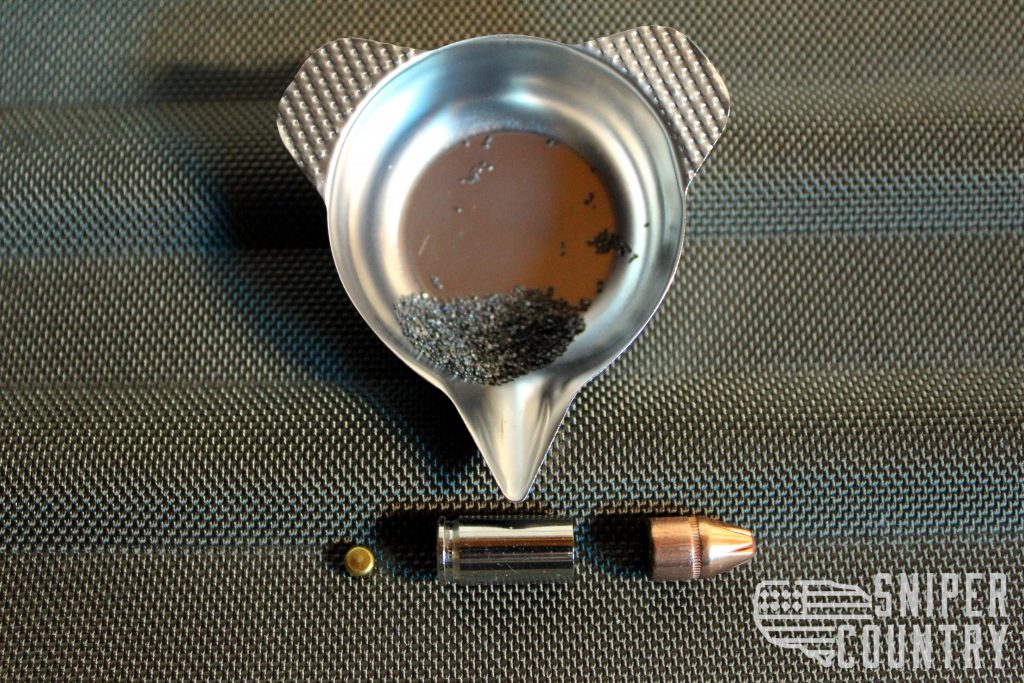
Hopefully, we all know what a bullet is – that’s the projectile that exits the barrel (at least that’s the plan).
While you’ll often hear people use “bullet” as slang for the entire cartridge, technically speaking a bullet is just one part of the cartridge.
Bullet Types
While any component of the cartridge can alter its performance characteristics, the bullet design will have the most impact on the target because it is what physically affects it.
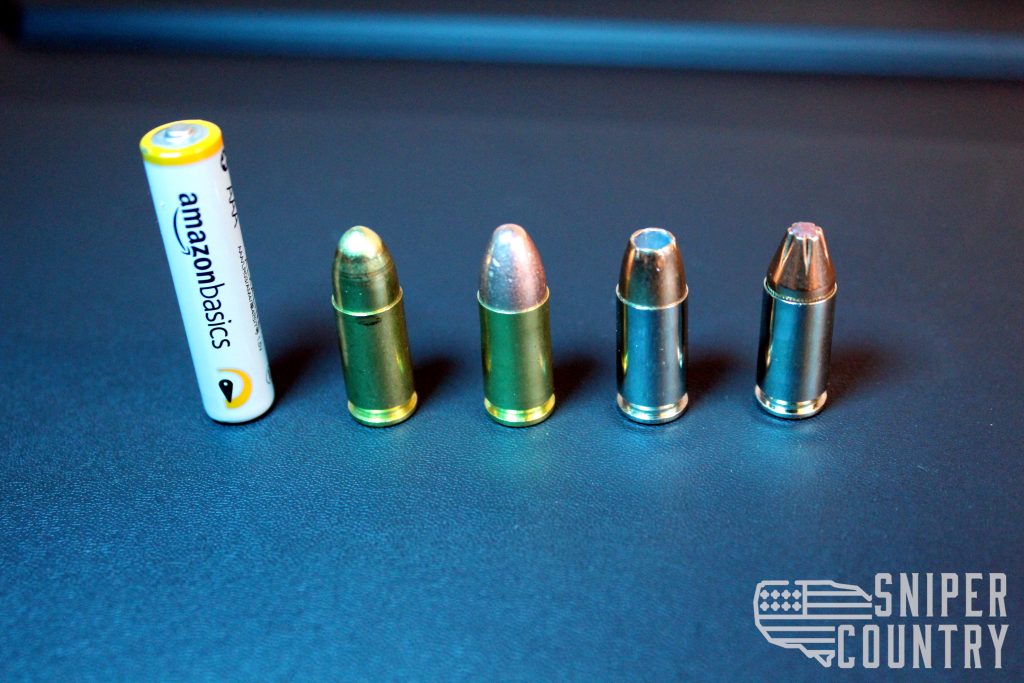
FMJ (Full-Metal Jacket): A copper “jacket” encases a lead core. Pretty simple and pretty cheap to make.
The important point is that only copper touches the barrel’s rifling, unlike a cast lead bullet that has no metal coating.
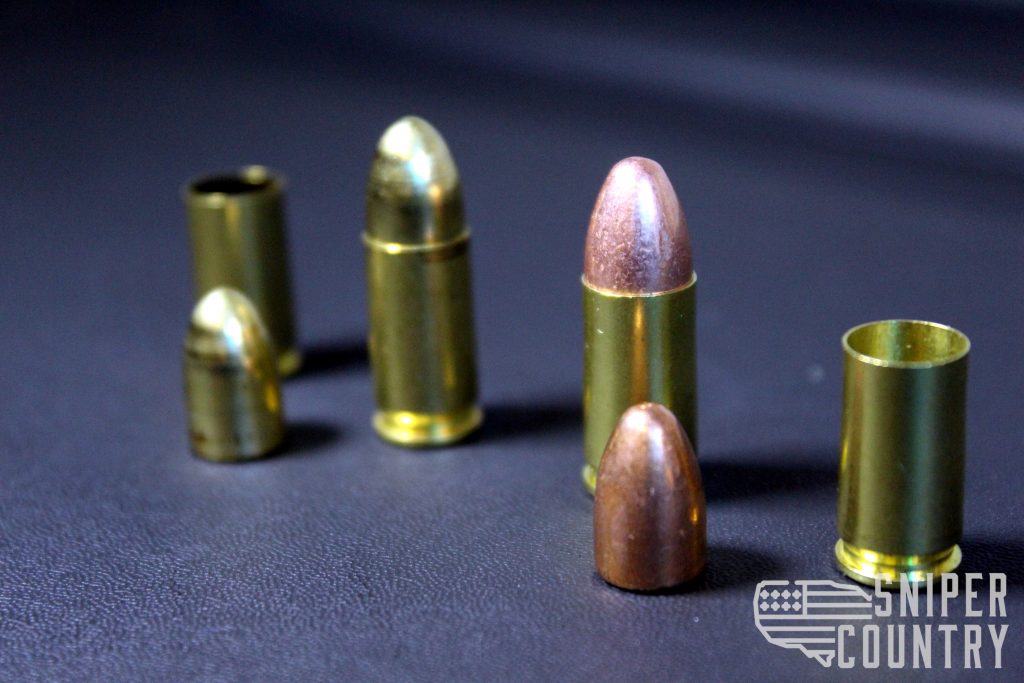
FMJ bullets are great for practice, competition, or as less expensive ammo in order to save costs.
JHP (Jacketed Hollow Point) – this bullet consists of a lead or other core covered by a copper jacket with a carefully engineered and tested opening in the bullet’s exposed, soft nose.
There are many different types and brands of JHP cartridges, more than we can list here.
To keep it simple, we’ll just say that the opening is there to enhance expansion once the bullet hits the target.
Engineered so that the bullet will split open and to allow “petals” to expand.
Once expanded, the bullet is commonly almost double the size and can do a lot more damage.
An added benefit is that it takes a lot of energy to do this and thus greatly slows the bullet in the target. This goes a long way in preventing overpenetration.
Other – there are a few newer bullet designs out that weren’t there a couple of decades ago.
Personally, I haven’t seen reliable third-party testing that proves these concepts out. I have see dozens of independent tests proving the effectiveness of JHP and HP bullets.
Cartridge
As partially explained above, a cartridge consists of a case, a bullet, some powder, and a primer.
For factory ammo, it is rare to know what exactly kind of powder is in each cartridge type, but the bullet weight and design should be readily available.
If you get into reloading, you’ll want to learn more about powder. Until then though, it’s okay to just trust the manufacturer.
A Note About Penetration & Expansion
Something I often need to remind new gun owners is that life isn’t a video game. You don’t have 100 Health Points and 9mm doesn’t do 1D10 piercing damage per hit.
However… Dead is dead. You can’t make something dead-er. Not even the best 9mm ammo can do that.
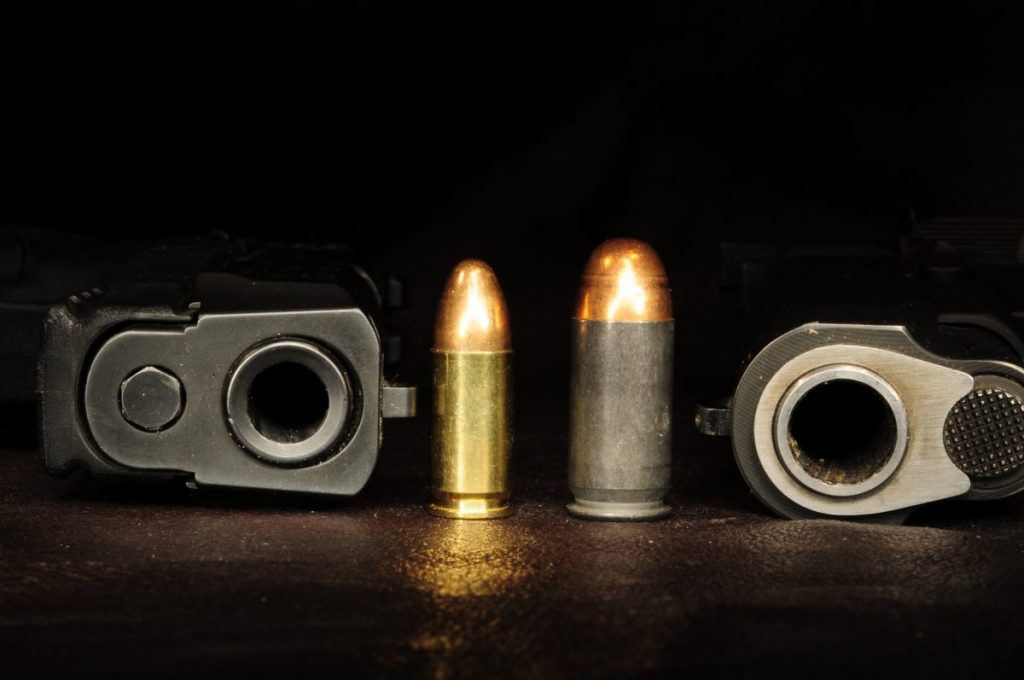
Some factors are related to the gun you are using, like barrel length. Others are environmental, like living in Southern California anytime Vs. North Dakota in winter.
We’ve got a lot of ground to cover, so let’s dig in.
Barrel length
Generally speaking, 9mm is designed for 4-5″ barrels. Getting ammo for barrels shorter than that is a niche application that has only recently been addressed in the marketplace.
If you’re using something shorter than 4″, you might want to double-check and see if there are some ballistic gel tests with your chosen ammo.
Climate
If you live in an area where shorts and T-shirts are pretty much worn year-round, you can get by with bullets that may not penetrate as far.
Conversely, if you are having to defend yourself in a cold climate where the bullet must get through a heavy coat or more, penetration becomes the deciding factor in what you buy.
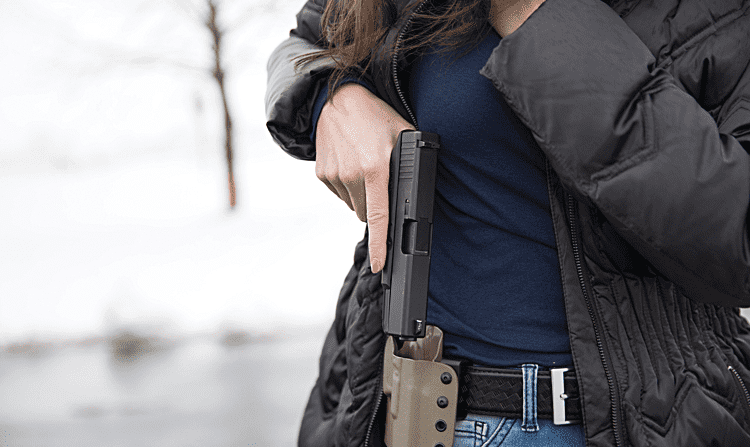
There is one path of thinking where FMJ bullets might be the answer for those of you living in the really cold areas where bullets need a lot of penetration.
You might solve the issue by using a hollow point round that is designed for penetration in addition to expansion (such as any of the options from Hornady that feature a polymer tip). That might be a more reliable choice.
Bullet weight
Common 9mm bullet weights normally available at most stores are 115, 124, and 147 grain.
The 115-grain loads tend to be higher velocity and the 147s somewhat slower, even subsonic.
A good compromise is a 124-grain bullet, this is also super popular with the police and military. In fact, NATO standardized on a 124gr design.
As with the climate comparison, you have a choice of going with zippier speed/great expansion or slower/better penetration. These are generalities, of course – exceptions abound in the real world.
I’ve mentioned penetration and expansion – what am I talking about, specifically? Let’s loosely define the terms as they relate to ammunition.
Penetration
Defined as piercing or passing through something. The FBI standard (a good standard to live by) looks for between 12 and 18 inches of penetration in ballistic gel.
Some rounds excel in penetration – in fact, they penetrate too well. One concern is that a bullet will pass through its intended target and injure an innocent bystander beyond the target.
Expansion
In relation to a handgun bullet, expansion is its ability to enter a target and end up at the end of its journey with a larger diameter than when it went in.
The bullet designed for expansion is usually a JHP, where there is a jacketed bullet body with a soft, sometimes exposed, lead or polymer tip.
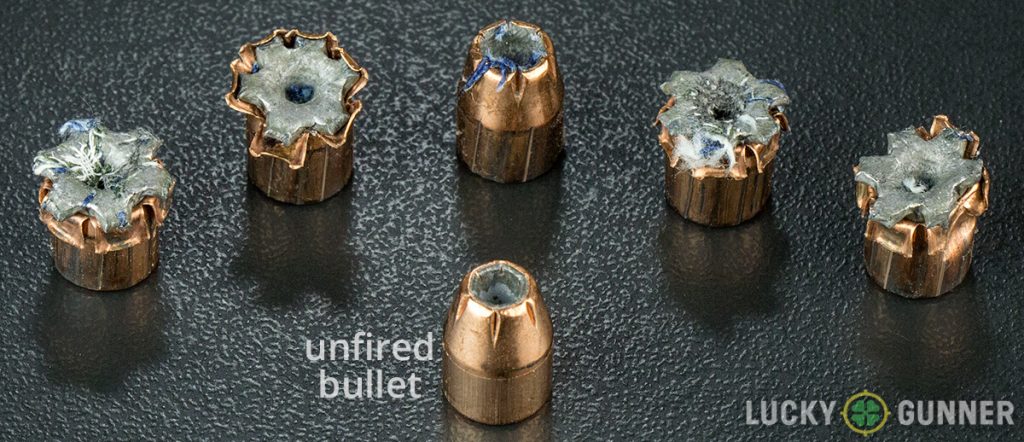
There are many different types of expanding bullets, but the differences don’t really matter a lot to the average person.
While they might take a different path to get there, they all get there.
Kinetic Energy
As the name suggests, this is the amount of energy the bullet has.
To figure bullet energy, take the bullet weight (in grains) times the square of the bullet velocity (in feet per second) divided by 450,437.
So, as an example, a bullet weighing 115 grains at a velocity of 1150 fps would yield 337.6 foot-pounds of energy.
Energy figures can be tricky and shouldn’t solely determine a bullet’s effectiveness. As I say below, sometimes energy looks good on paper but does not translate well in the real world in terms of the bullets’ actual effectiveness
If you want to test this information for yourself, a simple chronograph will help give you accurate data.
Choosing Self-Defense Ammo
Professionals and amateurs alike have published dozens, even hundreds, of tests and protocols for testing ammo.
While some of them are silly and some of them are practical, the gold standard is the FBI Penetration Test.
The FBI has tested thousands of rounds and has developed a standardized test to even the playing field.
We could do a whole article just on the test (and we should…) but the short version is that it tests ammo using a gel block and includes things like heavy clothing, drywall, simulated car doors, and automotive glass.
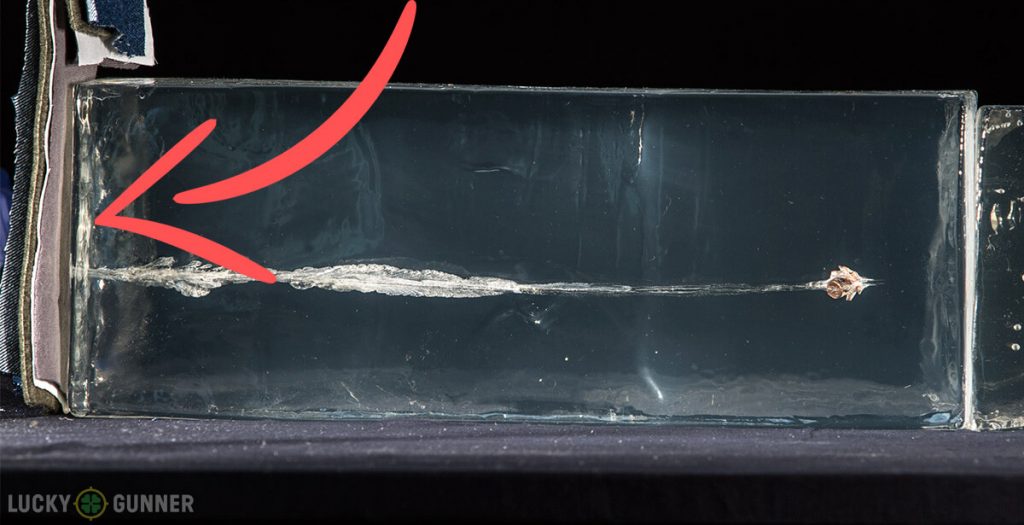
Generally, for the average public, the main thing we need to worry about is heavy clothing. Statistically speaking, it’s very seldom that a civilian needs to shoot through drywall, a car door, or a windshield in a self-defense shooting.
Winter layers, on the other hand, depending on where you live might be worn for half or more of the year.
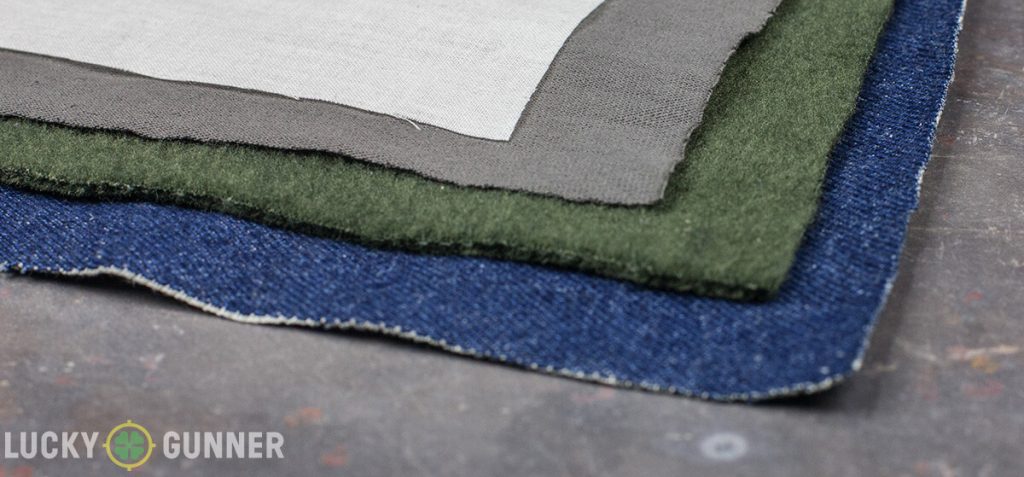
Good defensive ammo will penetrate heavy clothing, expand, and will not over-penetrate the body.
It can be hard to tell the good from the bad unless you set up your own ballistic gel. Thankfully the people over at Lucky Gunner have done a huge range of testing and that info is available to us.
If you’re ever in doubt about a brand of defensive ammo, check out their lab test results to give yourself a clearer picture of what is going on.
That said — all of the ammo types we recommend are ones we trust our lives to. We do so because we have researched them and shot them ourselves in training.
FMJ Target/Practice Ammo
Really there are only three things I want from my training ammo — I want it cheap, I want it reliable and I want the point of impact to roughly match the point of impact of my carry ammo.
And of the three, I’ll lean on the cheap side.
Be it for training or just for plinking on the range, FMJ ammo is perfect to keep your costs down.
Another great way to hurt your wallet less is to use steel or aluminum-cased ammo. Steel might be harder to find these days as most of the steel case ammo options came from Russia and those sources have been recently banned. Hopefully other countries will pick up the slack.
Aluminum- and steel-cased ammo should still be floating around though.
Both are great for making ammo costs less and they are perfectly safe to shoot in your gun. You might run into feeding or extraction issues though since those metals behave differently than brass.
That said, give it a shot in your gun.
Best 9mm Ammo (self-defense and on the range)
1. Magtech 115-Grain
Magtech is one of the most cost-effective brands of practice ammunition.
Normally, this is available at a reasonable price and in large quantities. I have gone through several thousand Magtech rounds and never had a problem.
It is cleaner than most inexpensive ammo, which is excellent. More complete burns of the powder result in greater MV and less cleaning.
Magtech, a member of CBC Global Ammunition, manufactures all of their own components. The ammunition is manufactured in Brazil, although the firm operates internationally.
2. Remington UMC 115-Grain
Another good buy in 115-grain practice ammo is the Remington UMC.
Remington as a company has had a rough time of it the past 10 or so years, but it’s looking like we’ll be seeing the brand come back in force soon.
Bought by Vista Outdoors during the Remington bankruptcy sale last year, they’ve been working non-stop to get things back up and running.
While everything else Remington might have gone down in quality during their final days, the ammunition line was about the only thing that maintained the quality that Remington was once known for.
Now in the hands of Vista Outdoors (who also own Bushnell, RCBS, Hoppes #9, Federal, CCI, Speer, Blazer, and a lot more), we’re confident that this will still be great ammo in any caliber.
Only time will tell if they remain one of the best 9mm ammo brands ever made.
3. Winchester NATO 124-Grain
If you’re looking for something with a little more oomph, Winchester makes a 124-grain NATO-spec cartridge that comes out to about 20¢ or so per round.
Finding true NATO spec ammo is not as easy as it seems like it should be, but Winchester does a great job of holding their line to high-quality standards and delivering a product that we can trust.
124-grain is also my preferred weight for self-defense ammo, so training with decent-priced and high-quality 124-grain NATO ammo is a good match-up.
4. Federal Train + Protect 115-Grain VHP
The first JHP round I want to discuss is something new from Federal.
The Federal Train + Protect and is loaded with what is called a Versatile Hollow Point (VHP) that weighs 115 grains.
The company, known for its many lines of excellent ammo for both handguns and long guns, introduced a load in 2017 that is a bit less expensive than a lot of self-defense ammo out there.
Using their proprietary VHP bullet, the round is touted as being more affordable, yet still very effective.
There is a huge benefit to being able to train with the ammo you also carry. Your POI will always match your sights, the recoil will always be the same, and you can stockpile one brand of ammo whenever you see it on sale.
The downside… since the ammo shortage started, this ammo has been very hard to find. Harder than even the other major self-defense ammo types.
5. Federal 124-grain HST
The Federal 124-grain HST is a round that was originally sold only to law enforcement agencies. Thankfully, it has been sold to civilians for the past several years and we love it!
Its track record is excellent in terms of use against hostile targets. It uses a non-bonded bullet, but the bullet tends to hold together with the best of them.
If you have either a shorty nine or a full-size duty pistol, the HST is a good choice. You’ll get good penetration, expansion, and performance with this round.
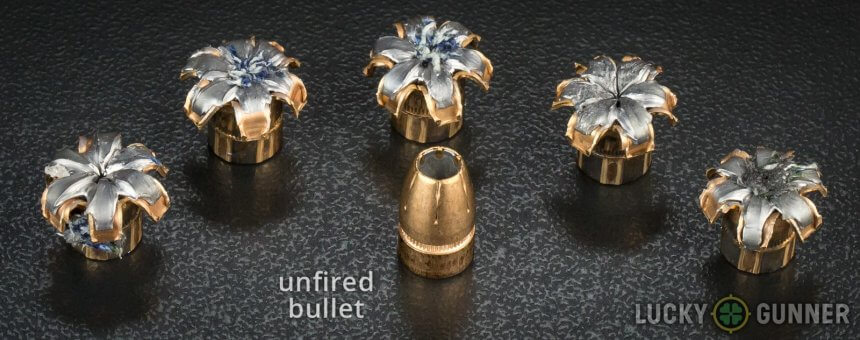
It passed the F.B.I.’s strict penetration requirements while expanding very consistently. Its reputation for breaching intermediate barriers yet still expanding is well known…that is one reason why police agencies use it.
It is also my preferred personal carry cartridge and my pick for the best 9mm ammo for self-defense out there. I keep my 9mm guns loaded with 124gr HST. I even keep my Ruger .380 loaded with 99gr HST.
6. Hornady Critical Defense 115 Grain
The Critical Defense round from Hornady has earned a great reputation as a reliable self-defense round.
What sets it apart is the nose of the hollow point bullet is filled with a flexible material that prevents the hollow point cavity from being plugged as it enters the target.
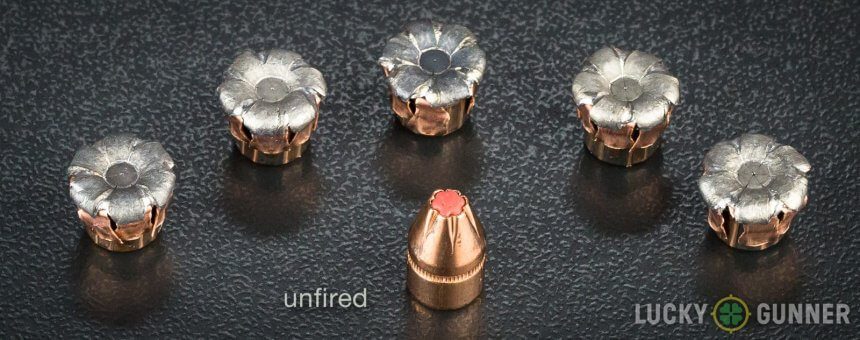
This also aids the expansion factor of the bullet as it is pushed backward.
Although kind of rare with modern bullets, the nose of an HP bullet can get plugged with debris, and can sometimes cause the bullet to behave like a solid-point projectile and just go straight through the target with little-to-no expansion.
Expansion is controlled, so you get very good penetration, as well.
If you want something with a little more spice to it, Hornady also makes a Critical Duty version that is loaded a little hotter.
In fact, the FBI has awarded Hornady with multiple contracts for Critical Duty +P ammo in both 9mm and 40 S&W.
These are designed for better barrier penetration, so increase the risk of overpenetration in say a home defense situation.
But if windshields are a concern for you, that extra power might be what you want.
If the FBI says it’s one of the best 9mm ammo options in the world, then you can trust it for sure.
7. Speer 115-Grain Gold Dot
The gold Dot has been around for a while because it is very effective.
According to sources, it is the #1 law enforcement 9mm round being sold.
It was one of the first 9mm rounds to use a bonded hollow point bullet, coupled with superb penetration characteristics.
When I can’t find my Federal HST for carry use, Speer Gold Dot is my second choice.
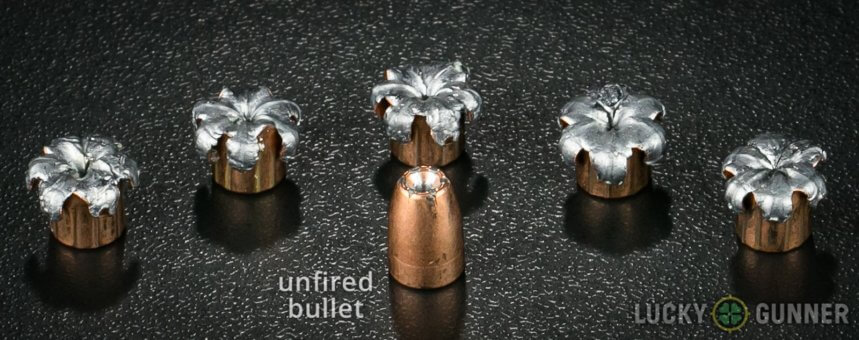
The nice thing about Speer also is that because it is the officially approved round for so many police departments, finding it in bulk is normally a lot easier than many other brands. Another possible advantage involves litigation after a shooting. It might go down better in court if you use the same ammo that the police useU nothing fancier or more “deadly”. Some prosecutors might be a bit less liable to hammer you on the ammo selection point.
If you want to train with what you carry and have the money to do it right — this is a great option.
8. Winchester PDX-1 Defender 147-Grain
Last but by no means least, let’s add the PDX-1 Defender round to our list.
The only round on our list to use a heavier 147-grain bullet, the PDX-1 has certainly garnered a great reputation.
Being one of three loads adopted by the F.B.I. as a duty/service load, the 147-grain load meets the tough protocols the F.B.I. imposes on its ammo. (The other two companies awarded contracts were Hornady and Federal’s parent company Vista Outdoors).
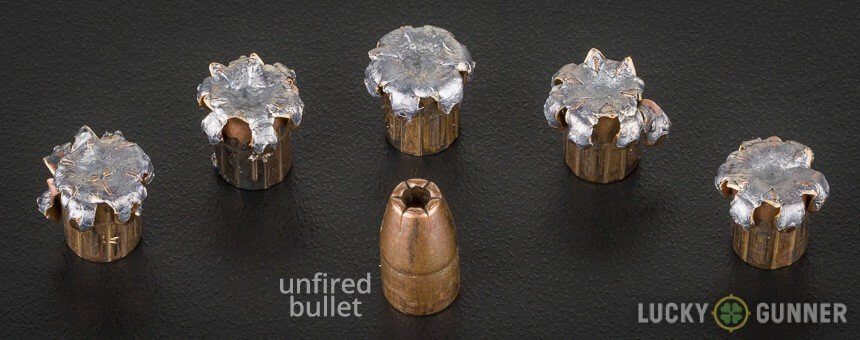
The round employs bonded bullet and nickel-plated cases for good terminal performance and reliable feeding, respectively.
Another benefit of the PDX-1 is that it uses a low-flash powder formulation, a definite plus when shooting in reduced light. If you’ve ever shot in darkness or right at dusk, the flash can be disorienting.
Imagine having to shoot in darkness or near-darkness at multiple assailants or someone shooting back – you get the point.
The PDX-1 is a great choice for a heavier 9mm bullet load. There’s something to be said about bullet weight and how it relates to momentum.
This is also a great option if you use a suppressor on an HD gun. Either carbine or pistol, subsonic defensive ammo is hard to come by but allows you to make your suppressor the most effective it can be.
One downside though is the price, even for one of the best 9mm ammo options out there — this is on the pricey side.
Conclusions
This was a lot of information to get through, but hopefully, you’re a lot more prepared now than you were before! Not only learning about the best 9mm ammo but a whole lot more to boot.
If I can leave you with some parting wisdom, I will. Choose proven ammo. Don’t get what is new or sounds cool, get what is common and standard.
There is a reason why the FBI or the LAPD or the NYPD trusts their lives to a select few brands of ammo.
For everything else, save as much money as possible and shoot more!
And in case you need even more to read, take a look at these:

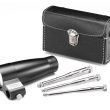
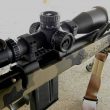

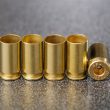
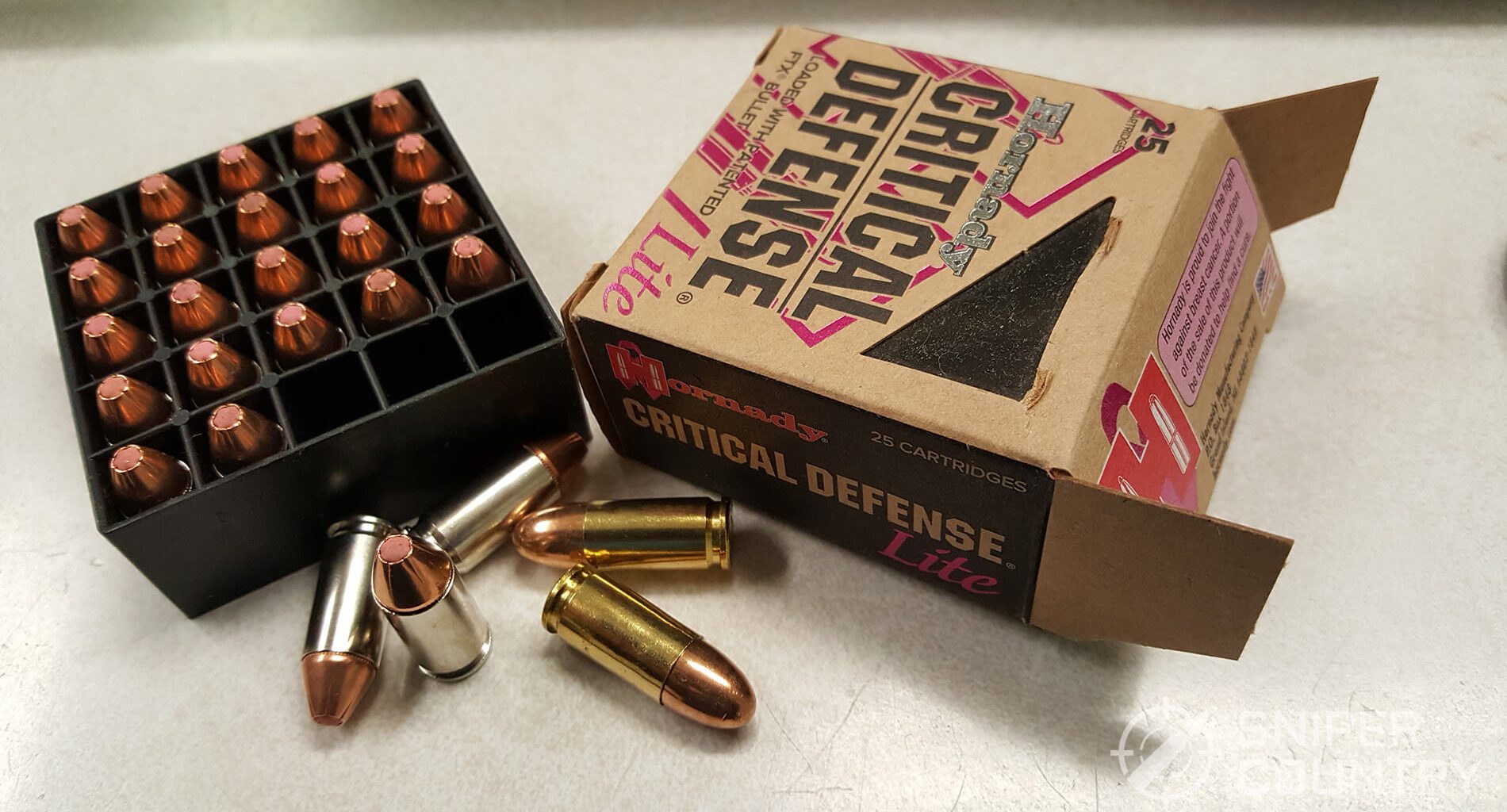
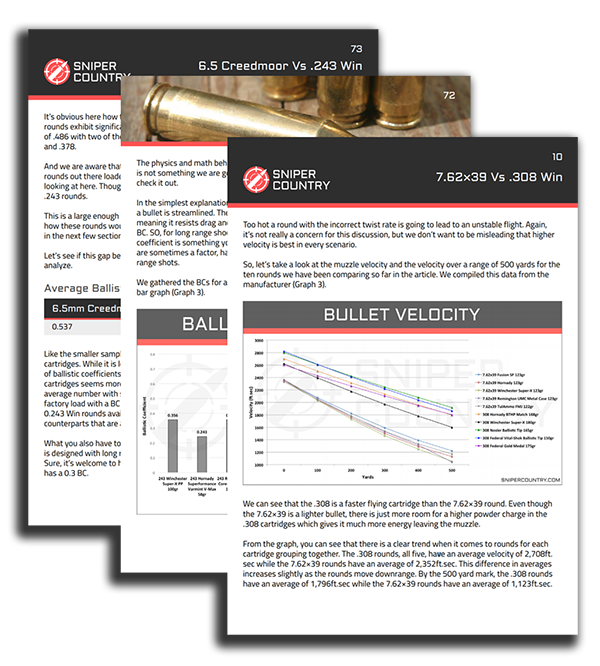


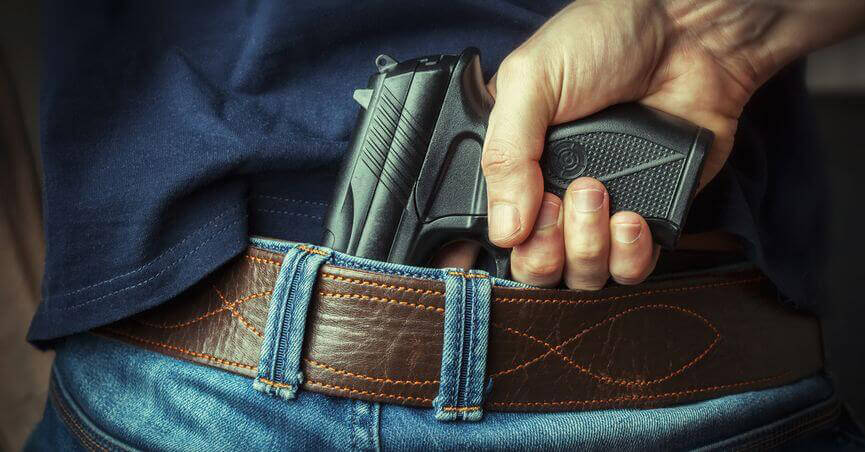
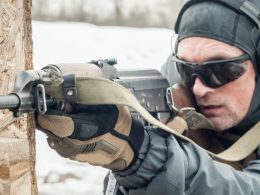
![Best Shoulder Holsters [2019]](https://www.snipercountry.com/wp-content/uploads/2018/06/Best-Shoulder-Holsters-2019-260x195.jpg)
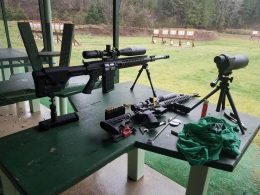
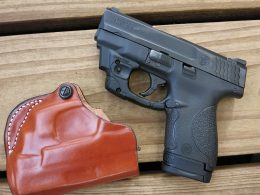
I wish you could have use the new Black Hills Honeybadger 125 gr. Round,
https://www.midwayusa.com/product/150958/black-hills-honeybadger-ammunition-9mm-luger-subsonic-125-grain-lehigh-xtreme-defense-lead-free-box-of-20
Or the Underwood’s 115 gr. Round.
https://www.midwayusa.com/product/688225/underwood-ammunition-9mm-luger-p-115-grain-lehigh-xtreme-penetrator-lead-free-box-of-20
Would of been great to see how they did against the big name manufacturers.
John, I would imagine that either of those rounds would do very well in tests, as real-world experience with them has proven. They are high-quality defense rounds with a good reputation. Thanks for the comment!
I’m a newb with a little help from a relative. I found this article extremely useful and I feel way more knowledgeable than before I read it. I bought a subcompact 9mm for home defense and hiking. I was looking for affordable practice rounds and reasonable defense rounds that I could afford to practice with occasionally. This article gave me a solid foundation. Thank you!!!
Mark, appreciate your comments. I do try to help, thanks!
Excellent article full of useful information. Thanks Mike!
Jeff, thanks for the kind words, and thanks for writing.
lehigh defense round from Underwood is a good round for cc.
Sarl, it sure is. It’s one of the best. Thanks for writing.
Merci Mike ???
Christian, thanks for the thumbs-up! I do try to give out information that will be helpful. Thanks for writing!
A lot of good info! I ‘d add a few points:
Bullet performance is a big factor in deciding viability as a defensive cartridge, but for me it’s probably not the biggest. I’d rather hit first with a somewhat lighter hitting bullet than hit second with a heavier one. In home defense situations you’re probably under 10 yards, so accuracy isn’t as big a factor in picking your loads.
But feeding reliability is, and for me that absolutely excludes any exotic bullet types or cases which could potentially increase the likelihood of a jam. No large-notched bullets or sharp angles for me, just more traditional round jacketed hollowpoints with brass or nickel cases.
One thing rarely commented upon in these types of articles is the effect of firing a weapon indoors on a shooter’s unprotected eyes and ears, especially in a darkened area just after waking up. A bigger blast is going to be more disorienting and make it tougher for follow up shots or quick decision-making. I would like to see some objective data on muzzle flash, recoil, and loudness. +P loads yield a ballistic advantage, but also produce significantly louder reports and sharper recoil. For me, the trade between a little more damage per hit and a little delay from my own muzzle blast is not worth it.
Keith, boy, you sure hit the nail on the head. Some loads/guns are SO loud and generate a huge fireball that you would be totally out of it in terms of seeing or hearing a threat for a long-enough time that the bad guy could do more damage. A good point – any studies done that anyone know of? Thanks for writing!
Not that I’ve done exhaustive research on ammo, but my gosh what an informative, easy-to-read-and-comprehend article. And flush with useful information to boot! My city has a gun show coming up soon and I’ll be using the lessons learned from your article as the basis for my ammo shopping.
Thanks a ton, Mike!
Kate, sorry for the late reply but I’m glad I could be helpful. Please let us know how the gun show buying went, and thanks for writing!
Mike, What do you think of the Ruger 57 and it’s ammo 5.7×28.
Edward, I’m on the list to receive a 57 for review – Ruger is sending me one to try. Stay tuned! Thanks for writing.
Am I wrong or does it look like the Federal HST ends up with the largest diameter expansion, and a nasty ragged edge for destruction? Any worries about feeding, as a fellow below said is more important to him (understandably) than a few hundredths expansion etc.
Marvin, no feeding issues that I know of. And, reliability is king – if a round won’t feed, fire or eject, its expanded diameter hardly matters. Thanks for writing!
Scratching my head here…….. For at least 100 years, FMJ has been “the” ammo issued to military and law enforcement across the globe, and then it seems with the advent of “exotic” ammo, it’s been relegated to “training” or “target” ammo status. My dad fought in WW II, Korea, and Vietnam. I did two tours in Vietnam, and my son was a Navy SEABEE. ALL of our ammo over those years was FMJ, and I can say it worked very well in combat situations. Why has it suddenly become relegated to an almost undesirable status?
Dave, I don’t think it’s been demoted – I just think FMJ is cheaper to manufacture than JHP or other types of bullets so it gets used more for training and target work. After the Hague Declaration of 1899, countries thought that all JHP-type bullets were banned for warfare, but it actually said only those bullets that were meant to cause excessive bodily harm were not to be used, or words to that effect. I do believe we use JHP ammo now, since about 2015, but I could be wrong. I think it’s mostly due to the cost savings that FMJ enjoy over JHPs that the former bullets are used in training and target situations. Evidently, the Army in particular wanted expanding bullets issued, especially when they went with the Sig M17. There is nothing wrong with FMJ ammo, but expanding bullets are very popular. I am not an expert on this matter – does anyone else out there have a comment about it?
I would think with the military, FMJ is the way to go. You need max penetration due to your target is heavily dressed, with a pack, all kinds of other combat items. I would think penetration should be @1. Different scenerio in normal situations at home and on the street, FMJ would penetrate way too much. Just my 2 cents..
Great article and good info as always. My choice’s with 9mm I simplified based on barrel length…4″ or longer is HST 147gr, less than 4″ is corbon dpx 115+p.
Adam, good choices. You won’t be disappointed. Thanks for writing!
Great article Mike, and I downloaded the pdf for later perusal.
Chuck, glad it helped you. Thanks again for writing!
You do know that when the FBI makes an ammo decision, it’s as easy as them walking across the street and asking the DEA FTU what they are using, right? And then going with the same ammo. Just as when DEA wants to decrease shooter proficiency standards, shorten the course, decrease funding for training, ammo, and equipment, and cheapify the whole training experience, they walk up the hill to the FBI FTU, and ask what the FBI is doing, and copy it!
Fred, that’s good – you’re probably right! Who knows how things are really decided… not me, for sure! Thanks for writing.
As I read over this, a few things came to my mind.
If we are talking about hollowpoint bullets designed to deform in soft tissue, as a rule they tend to penetrate more after penetrating heavy clothing, not less. This is because they become clogged with clothing fibers, which can delay or reduce expansion, sometimes even prevent it. Only since around 1990 have the bullet designers taken this into account. The International Wound Ballistics Association recommends a test in which the gelatin block has four layers of heavy cotton canvas denim, sixteen ounces per square yard, placed over it. This represents a worst case scenario. A bullet that can expand after four layers of denim will expand reliably after nearly any realistic clothing barrier, even multiple layers of winter clothing.
I believe that kinetic energy is important but the way we usually test pistol ammunition today doesn’t show it. The tests we do now mainly come down to selecting bullets that penetrate more than a certain minimum in gel and less than a certain maximum, with overpenetration being less important than underpenetration. When a bullet meets these parameters, the widest expansion and greatest volume of displaced gelatin in the block are judged to be the best, and this is held to be the be-all and end-all of bullet performance. Bone is judged to be an imponderable, impossible to simulate, so they ignore it. Only, see–soft tissue is, like water, like softwood, a soft barrier. Depth of penetration can generally be predicted easily–momentum divided by expanded diameter. Bone is like metal, a hard barrier. With hard barriers velocity and kinetic energy come into play. High velocity and high energy are the qualities that allow a bullet to shatter bone in a way that drives sharp splinters into surrounding tissue in a way that makes the wound more severe, and continue in a straight line instead of deviating or even stopping, as low-velocity, low-energy projectiles are prone to doing. This was known long ago. The Army did a big study in 1946-47 and did a lot of interviews with military surgeons. Everyone told them that 9mm bullets, especially when they’d picked up some extra velocity from being fired through the longer barrel of an SMG, had much greater propensity to shatter bone than .45 ACP.
…also, NATO specs for 9mm ammunition specify a particular chamber pressure within certain parameters for reliability in the open-bolt SMGs that everybody else in NATO other than the US issued to front-line infantry back when the specs were written. Bullet weight can be anywhere from 7 grams (108gr) to 8.5gr (131gr) and still be “NATO spec.” US 9mm M882 Ball ammunition uses a 124gr (8 grams) FMJ roundnose bullet. We borrowed almost all the specs on M882 from the West Germans, and most of NATO does use an 8 gram FMJ bullet loaded to around 38,000 PSI, for around 1200 ft/sec out of most full-size handguns, but it isn’t universal and it isn’t mandated by NATO specs. The Brits and Canadians have used 115gr (7.5gr) FMJ roundnose 9mm SMG ammo for eighty years, and that ammunition is compliant with NATO specs.
Otherwise, let me see. Federal HST is a very good bullet design, it’s on the short list of best choices for duty and defense, but they keep changing the design year over year to get a little more penetration or a little more expansion. A few years back 147gr 9mm HST expanded to .75″ or greater in clothed gelatin but only barely got to 12″ of penetration, and some of Federal’s law enforcement customers asked for a redesign. They’re doing this constantly. And some years, yes, the design process has resulted in HST bullets with hollowpoint cavities so wide they cause feedramp stoppages in some guns, depending on how worn the magazine was and how good the magazine spring was. HST is very good but it isn’t magic.
In 9mm it generally seems to be accepted that the really good duty and defense rounds are:
Federal HST, 124gr +P or 147gr
Federal Tactical Bonded 124gr +P (has been discontinued)
Federal “Punch” 124gr (velocities indicate it is probably loaded to +P pressures, if not +P+)
Remington Golden Saber, 124gr +P or 147gr (Remington “Black Belt” and “Ultimate Defense” seem to be this stuff, but rebranded)
Remington Golden Saber Bonded, 124gr +P or 147gr
Winchester T-Series, 124gr +P, 127gr +P+, or 147gr
Winchester Ranger Bonded, 124gr +P or 147gr (PDX is very similar and may be identical)
Winchester White Box 147gr JHP is surprisingly good (the 115gr in this line overexpands and underpenetrates)
Speer Gold Dot, 124gr +P or 147gr
Hornady 124gr TAP or American Gunner 124gr +P
Hornady 124gr +P or 135gr +P Critical Duty
Cor-Bon 115gr +P with Barnes monolithic copper hollowpoint
115gr expanding bullets in 9mm as a general rule have a tendency to overexpand and underpenetrate, or at least do not perform as consistently after barriers like heavy clothing as 124gr or 147gr bullets. It is possible that the 115gr Hornady XTP would perform well at +P+ velocities but I am not aware of any ammo maker making anything like this available to the public. Remington used to sell +P and +P+ law enforcement loads with their old-style 115gr conventional copper jacket JHP, and it was generally a good performer at those velocities but doesn’t seem to be available any more. Hornady’s 147gr XTP hollowpoint is sometimes prone to clogging when there is an intermediate barrier of heavy clothing, as is the old 147gr Hydra-Shok from Federal. The 124gr +P+ Hydra-Shok from Federal was a decent performer but I don’t think they make it any more. The old Winchester Silvertip 115gr JHP was infamous for overexpanding, fragmenting, and failure to penetrate adequately. The old Federal 115gr +P+ “9BPLE” load also had a tendency to overexpand and fragment, and not penetrate very well, though it could be effective on unobstructed body shots, just like the 115gr +P from Cor-Bon. The old Federal 9BP 115gr standard pressure load was a little less prone to fragmenting but had the same problems with adequate penetration, just to a lesser degree.
+P and +P+ are always to be preferred. 147gr bullets are so long that they leave little room inside the case for powder, and going up to +P or +P+ pressures usually does not result in much additional velocity. There is no good reason for 9mm standard pressure ammo with bullets lighter than around 140 grains to exist except for training and target competition, though. Any increase in recoil or muzzle rise is minimal, the extra pressure and recoil impulse help reliability of some firearms, and when we are talking about handgun bullets, every little bit, every tiny increment in performance, helps. Not enough tests or performance data have been made available on most of the 135gr loads for me to be comfortable making any recommendations.